The rise of online learning has led to the emergence of a wide range of digital resources for education. The pandemic, the increase in remote or home working and the cost-effectiveness of remote learning over classroom learning have all played their part in this rise.
A huge number of schools, colleges, and universities have also embraced eLearning. They regularly use online learning strategies to provide more flexible learning while still maintaining quality.
Online learning faces a significant challenge though. That of maintaining the focus of students when there are so many distractions.
Classroom learning sets the scene and the mindset. There are fewer opportunities to become distracted and more opportunities for interaction with other students and the teacher.
Additionally, with the widespread adoption of online learning, students often find themselves navigating various digital distractions, such as social media, emails, and browsing, which can impact their focus and engagement.
Tools like Google Chrome extensions designed for productivity and focus management can play a crucial role in helping learners maintain concentration during their online learning sessions.
You don’t have those advantages with remote students.
Which presents a challenge.
How can you keep students focused when you cannot see what they are doing?
One answer is gamification.
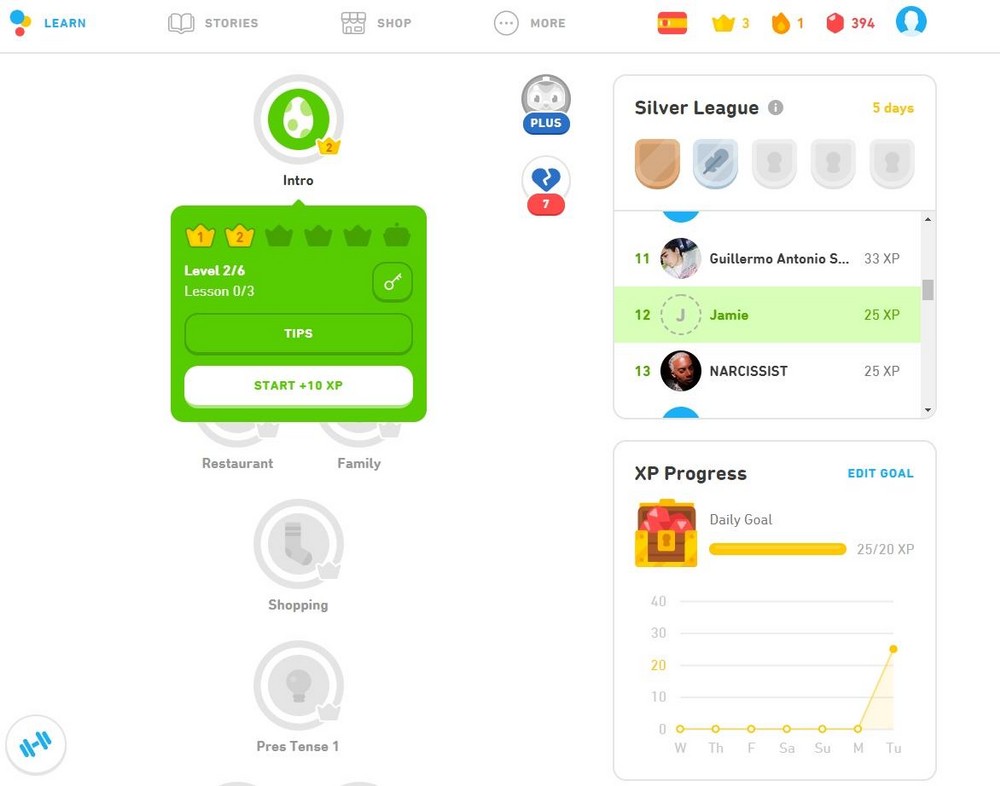
What is gamification?
Gamifications is the addition of game mechanics to non-game activities.
In the context of online learning, that means using elements typically found in popular games within lessons.
Those elements can include:
Points – Either general points or XP (eXperience Points) can be integrated into lessons to encourage competition and the desire to get to the next level. This is a powerful motivator in games that can be equally powerful in learning.
Levels – Levels feed into our innate desire to improve ourselves. The career ladder or belts for martial arts are real life examples of levels. They aren’t just an expression of your expertise, but also something to work hard to attain that can provide tangible results.
Missions – Many of us are task-oriented and missions can play a part in that. They provide structure, ‘go here, do that, return’ and get a reward, ‘complete the mission for 5000 points or to reach the next level’.
Badges – Badges provide recognition and feed into the achievement cycle. It also provides motivation to earn badges to show off to your peers.
Rewards – It isn’t just dogs that will do anything for a reward. People will too. While the form of the reward may differ, the basic psychological driver behind rewards is exactly the same!
Some examples of gamification in society
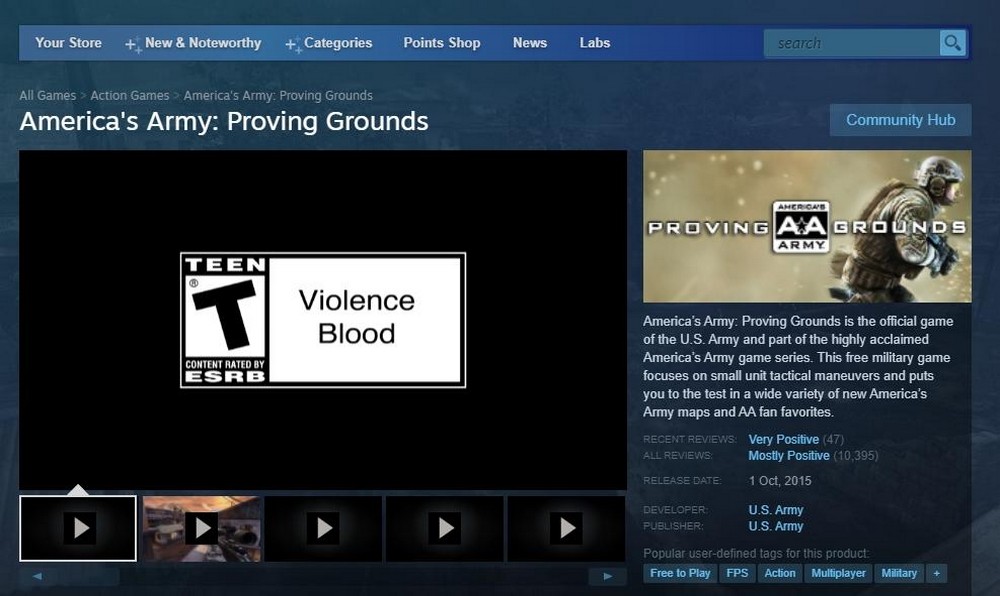
The US Army – The US Army used a game for recruitment, called America’s Army. It proved very effective when active as it showcased the army’s values and many role types within an actual game.
The army itself uses gamification elements too. It uses ranks as levels. Work hard and you’ll reach the next rank.
It also uses badges. Work hard to specialize and you’ll earn a special badge, Combat Infrantryman, Combat Medical Badge, Expert Soldier, Army Pathfinder Badge, Air Assault Badge and many others.
Strava – Have you used Strava? It’s a fitness tracking app that gamifies exercise. It uses levels, badges, missions and leaderboards to create that competitive atmosphere to encourage everyone to work out more.
It also encourages people to use Strava more, which is why it’s so effective.
Coffee shops – Some coffee shops use a very simple but effective gamification method that uses rewards. They give you a card and stamp that card every time you buy a coffee. When you complete a card, you get a free coffee.
It’s the simplest form of gamification but also one of the most powerful.

Duolingo – Duolingo is a language app that takes gamification to a new level. The app is designed just like a game. It has levels, badges, rewards, power-ups and a leaderboard.
Duolingo is the ideal case study for using gamification in online learning!
Why does gamification work?
There are a few good reasons why gamification works both in everyday life and particularly with learning.
Here are just a few:
The reward
We love rewards. Whether it’s an afternoon off work for helping out at the weekend or a new job title, it feeds into that achievement cycle we mentioned earlier.
The reward doesn’t have to be significant or valuable. It just needs to be measurable and be comparable to our peers.
Reinforces the desired behavior
We used a dog training analogy before, but gamification uses the same principles.
When a student completes a lesson or scores well on a quiz, they get rewarded. They do it again on the next level, the same thing happens.
It’s a cycle, rewards for tasks compound to further reinforce the desired behavior.
Sense of achievement
Achievement is a huge psychological motivator and one of our most fundamental. For any human to do anything, there must be something positive at the end of it.
Whether that’s financial, tangible, intangible, unique or everyday, achievement is an incredibly powerful motivator.
It’s why we get up in the morning, to achieve our daily tasks. It’s why we go to work, decorate our homes and learn new things. It’s why we do most things in life!
Setting and meeting goals
Not everyone is consciously goal-oriented but almost everyone is at some level. Humans are competitive and want to push ourselves further and achieve goals.
Goal setting is also useful as it gives us agency, even if it’s just the illusion of choice. Using project management tools can helps to organize tasks and track progress efficiently towards these goals.
Set a goal of learning something within a time limit and almost everyone will fight to achieve it.
Use achievement, reward and levels or badges and you compound the effect exponentially!
The benefits of gamification
Gamification provides enormous benefits that help engage your students to keep up with courses and learn.
The following are some of the benefits of gamification:
- Increases engagement
- Adds a fun factor to any subject
- Provides instant feedback
- Encourages online learners and tutors
- Instills motivation through achievements like points, ranks, and badges
- Provides a sense of autonomy and choice
- Can encourage students to push themselves and excel
Use cases for gamification in WordPress
There are a multitude of uses you can put gamification to in a learning context.
Online education
Online tutors and students can use gamification to provide intuitive and interactive learning.
It can be easily implemented on learning websites as well as universities, colleges and schools to provide a much more engaging experience.
Customer training
Gamification can be applied to customer training too. If you provide products that require training to use properly, an online course could work perfectly.
For example, customers can easily earn special bonuses when they fulfill product knowledge requirements through an online course. You could use mild gamification methods to encourage course completion and sharing, which could encourage others. Additionally, incorporating cloud phones for seamless accessibility and communication can enhance the overall learning experience.
Employee training
Employee training and professional development are two significant use cases for gamification. In conjunction with these initiatives, organizations can further optimize productivity by implementing employee time tracker software to monitor and streamline work hours during training.
For the same reasons as customer training, you can encourage staff to utilize your learning resources to enhance their skills, acquire new knowledge, and compete with their peers, all with the assistance of voice AI. By incorporating voice AI into training modules, employees can engage in interactive learning experiences, receive real-time feedback, and access information hands-free, leading to more effective and efficient learning outcomes.
Best WordPress gamification plugins for a course website
There are a number of gamification plugins for WordPress that can be used with online learning.
myCred LearnDash
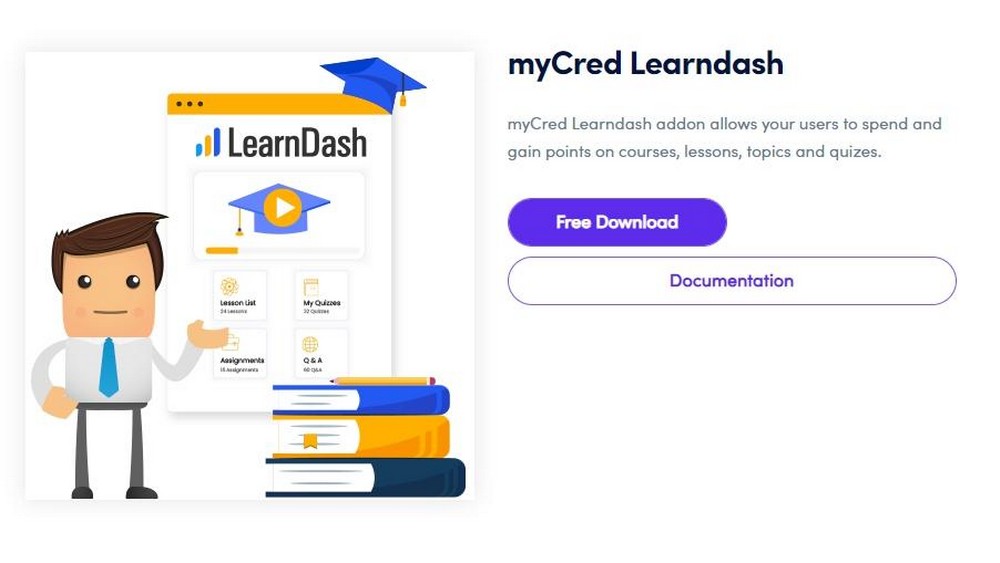
myCred LearnDash is a WordPress gamification plugin that enables you to create points using the LearnDash learning management system.
If you work as a LMS administrator, you also can significantly enhance your role through the strategic implementation of gamification in online courses. This approach not only adds a layer of excitement to the learning experience but also streamlines the administrator’s task of managing and optimizing the Learning Management System.
It provides a mechanism to introduce gamification elements to courses to trigger all those psychological influences we talked about.
It can award points when students complete their courses, lessons and quizzes. It can also be integrated into a wider gamification strategy to allow students to gain points and badges as they progress.
myCred has a lot of these features built in, but supports hooks if you want to add some of your own.
Features of myCred
myCred enables you to make online courses much more engaging and interesting for students in a number of ways:
- Buy courses – Enables users to buy courses using myCred points
- Leaderboard for courses, lessons and topics – Builds leader boards to display student scores to encourage competition
- Leaderboard for quizzes – Creates leader boards to display quiz results for the student or their peers for a different level of competition
- Supports multiple payment gateways – Enable students to use myCred points or real money to buy courses
- Automatically awards points – Give personal points when students complete a course, lesson, topic, or quiz
- Manages Logs – It helps users easily manage their user logs and point balances
GamiPress
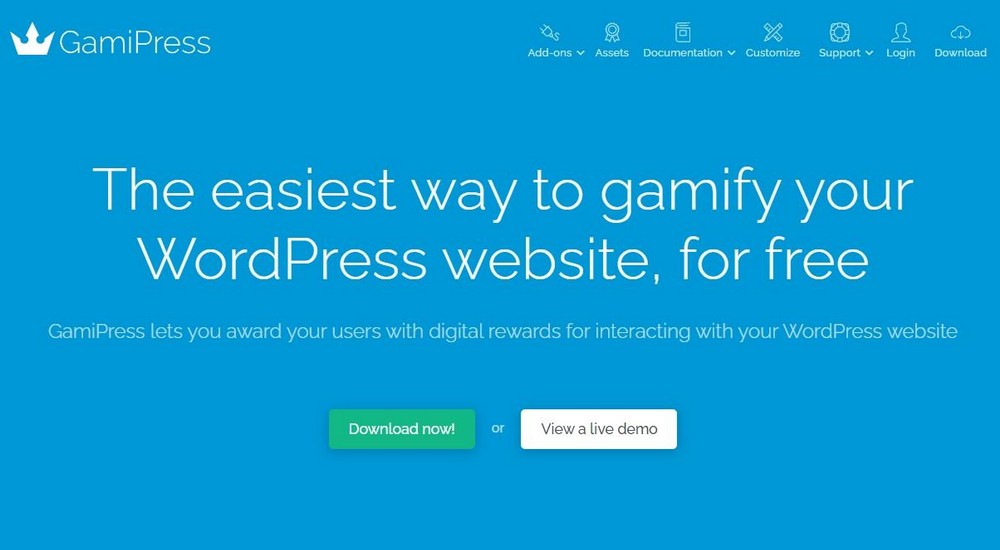
GamiPress is another gamification plugin for WordPress. It enables you to use points, achievements and ranks anywhere on your website.
GamiPress provides multiple types of points and achievements and multiple achievable ranks. You can configure the plugin to automatically award points or set custom limits, it’s up to you.
It has a definite use in online learning as the plugin’s simple drag and drop editor allows you to add gamification elements anywhere, for almost anything. It’s a very easy plugin to get to grips with and has a lot of useful functionality.
GamiPress is also free and open source.
Features of GamiPress
GamiPress has all the features you look for in a plugin of this type, including:
- Multiple point, achievement and rank types – Choose from multiple types of badges, points and ranks depending on the type of website you have
- Simple drag and drop editor – Build gamification into online learning with ease using a drag and drop editor
- Automatic or custom award controls – Use the plugin’s automatic tools or set custom limits or times for awards
- Logs for everything – Monitor everything and enable students to check what’s happened with loggin
- Email notifications – Be notified of key moments or new awards with built-in email notification tools
- Compatible with Open Badges – Use third-party award types for your LMS
BadgeOS
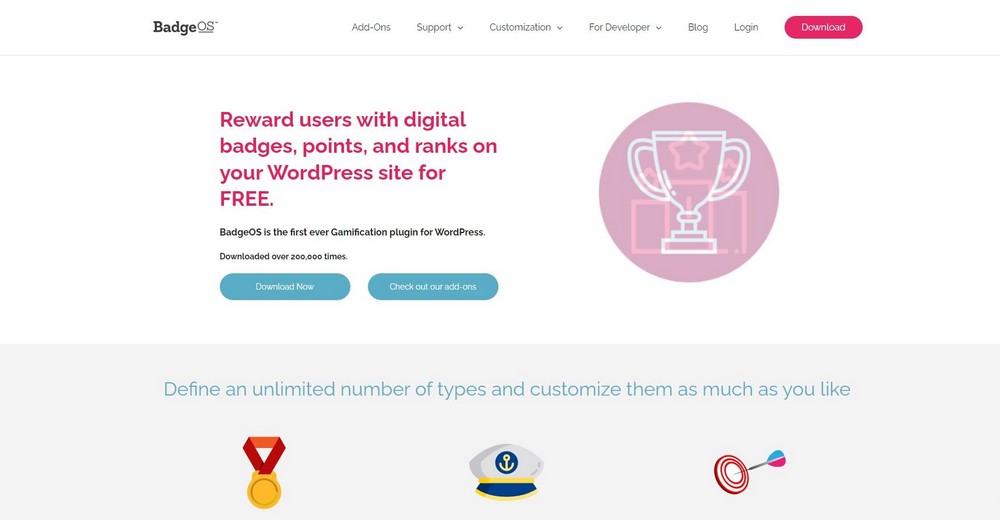
BadgeOS is another free gamification plugin for WordPress. It looks and feels a lot like GamiPress and offers similar features and benefits.
The plugin includes multiple achievements, ranks, points and badges to help gamify your website. It also has a very neat ‘Required Steps’ manager that outlines exactly what a student has to do to achieve the next badge or rank. This can be a powerful motivator!
BadgeOS also comes with an achievements widget so students can display their awards and see exactly what they have, which can be another motivator.
Overall, BadgeOS is a comprehensive plugin that has many gamification features available for free with extras available as premium addons.
Features of BadgeOS
BadgeOS offers a lot of features ideal for online learning websites:
- Multiple achievement types – Achievements, ranks, points and other types of achievements
- Badge and achievement design tools – Design your own badges or rank insignia with a built-in design tool
- Required Steps manager – Provide motivation to progress with a widget that shows students what they need to achieve the next rank
- Shortcode support – Configure gamification anywhere on your website using shortcodes
- Submission and nomination tools – Allow students to nominate each other or recommend awards
- LearnDash compatibility – Set awards triggers within LearnDash with a free addon
LearnDash Quiz Import Export

The LearnDash Quiz Import Export plugin enables you to quickly feature quizzes within your eLearning website.
The plugin provides a template for you to use to build quizzes and includes multiple question types to keep students interested.
It’s a simple but effective plugin that lets you import readymade quizzes directly into LearnDash and include them within courses. You will need to have your quiz in Excel (xls or xlsx) format, but otherwise, the tool makes short work of adding and including quizzes.
The LearnDash Quiz Import Export plugin is very useful if you want to gamify your LMS with quizzes and make short work of importing and implementing them.
Features of The LearnDash Quiz Import Export plugin
- Supports the import of quizzes into LearnDash – The plugin includes simple import and export tools to add or back up quizzes
- Template to assist building quizzes – Need help building quizzes? The plugin can help with that
- Supports multiple question types – Supports multiple types of questions but may need another paid addon
- Simple editor for updating questions – Want to change or correct a quiz question? The quiz editor can help with that
- Good supporting documentation – The documentation for this plugin is particularly good and should help with any questions you may have
These are four great gamification plugins for WordPress and they all have their strengths and weaknesses.
For the purposes of this post, we’ll use myCred LearnDash as it has a decent range of features we would look for within a course website.
What do you need to run myCred LearnDash?
myCred LearnDash is a popular and robust plugin that works seamlessly with your WordPress website.
The following are some of the prerequisites needed to install the myCred LearnDash plugin:
- The myCred plugin
- Working WordPress installation
- LearnDash
- PHP 5.3+
We also recommend having a LearnDash theme up and running so you can begin accepting students right away.
Installing and configuring myCred LearnDash
The following are some of the steps required to install the myCred LearnDash plugin:
Step 1
1. Log into your WordPress dashboard
2. Select Plugins > Add New and search for ‘myCred’
3. Select Install and Activate
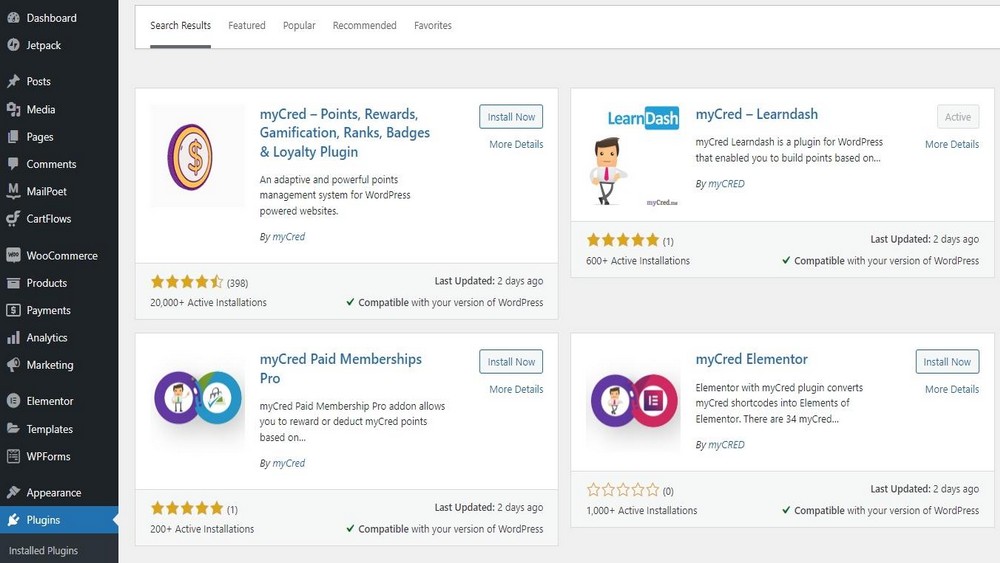
Step 2
Once you click activate, you should see the setup wizard.
You only need to do this once, but you do need to do it in order to set up the plugin for use.
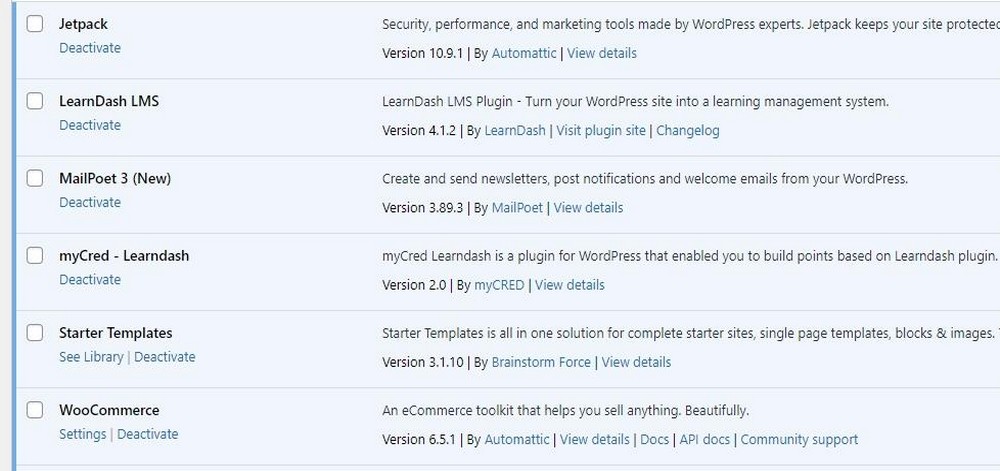
Step 3
Now we need to create our first point type. This determines what points look and feel like, how they are presented, and the capabilities that are used to identify them.
You can use one point type or multiple types. We would recommend setting up a single type of point first. You can always add more later!
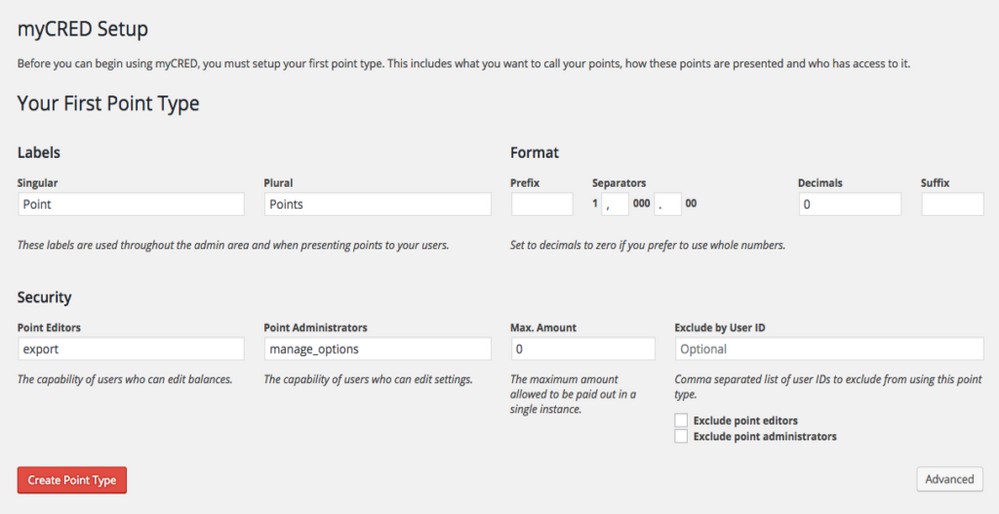
Step 4
Next, work through all the different menus the plugin has created. The default settings should be enough to get you started, but now is a good time to set everything up.
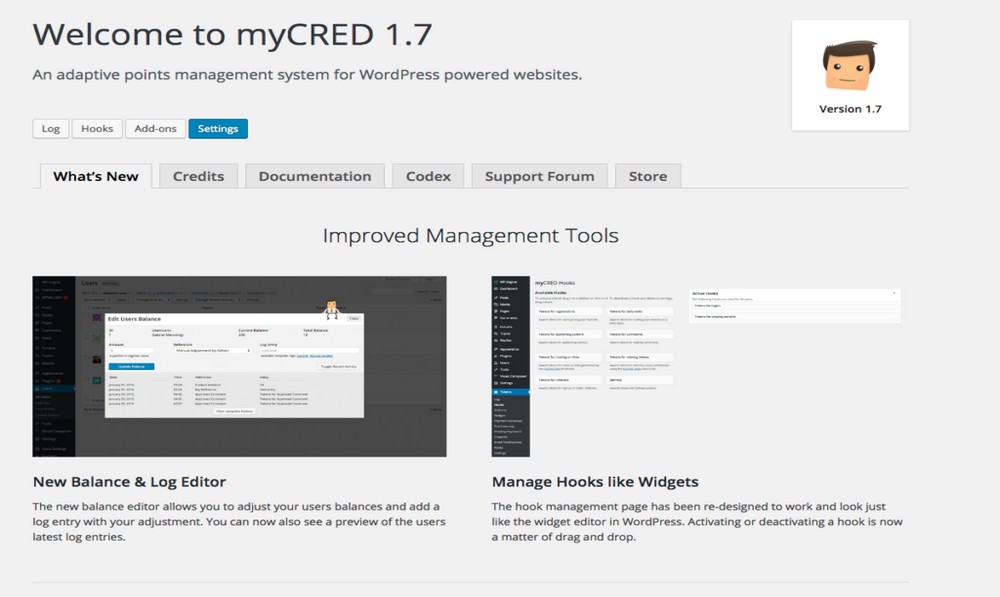
Point type preferences
Each point type has its own settings page. Here you will find your point-related settings and the settings of the relevant addons.
Core settings
The setting for point type is made up of four sections:
- Label – Handles the point type label (the name) in singular or plural format
- Format – Handles how points are formatted and highlighted on your website
- Security – Handles the security-related settings that include the capabilities of defining the “point editor” and “point administrator.” Also, you can set the highest point value that myCred is allowed to give permission rights and set your exclusive settings
- Other – Currently, ‘Other’ handles the option of deleting log entries when a user is deleted
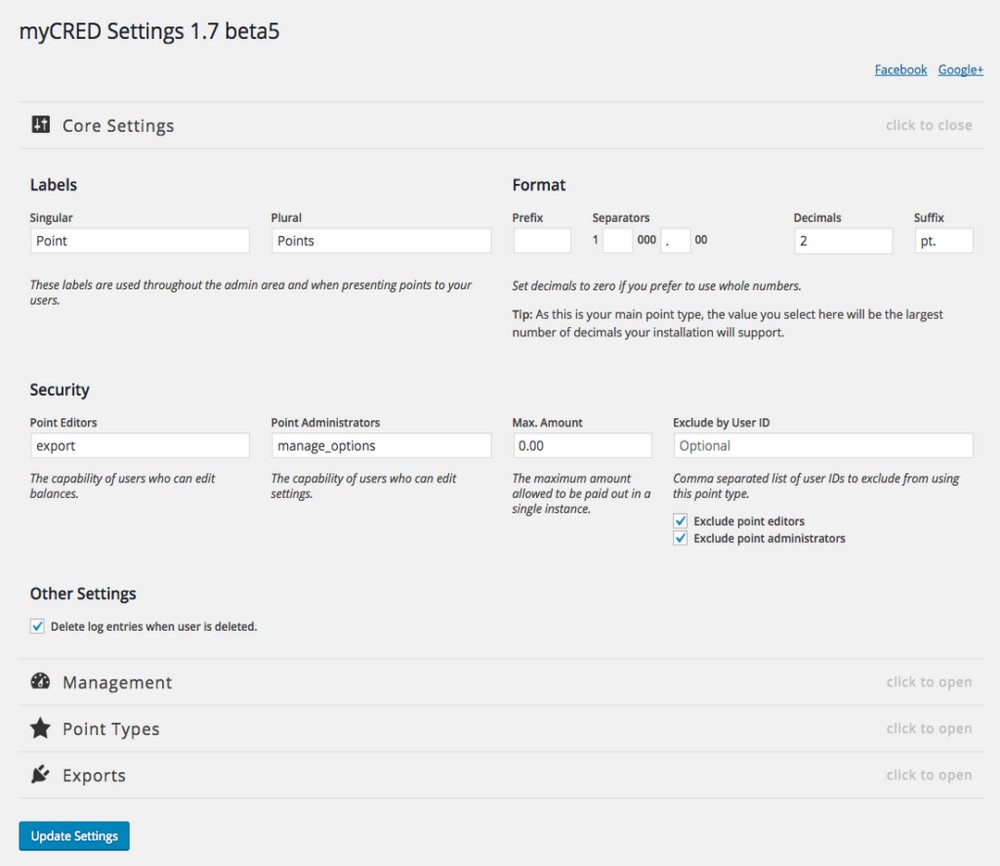
Set up general settings for courses, lessons, topics and quizzes
Setting up myCred will take a few minutes but it’s a very straightforward process.
Adding points requires setting up a hook. That’s easy, as myCred has set everything up to work just like WordPress widgets.
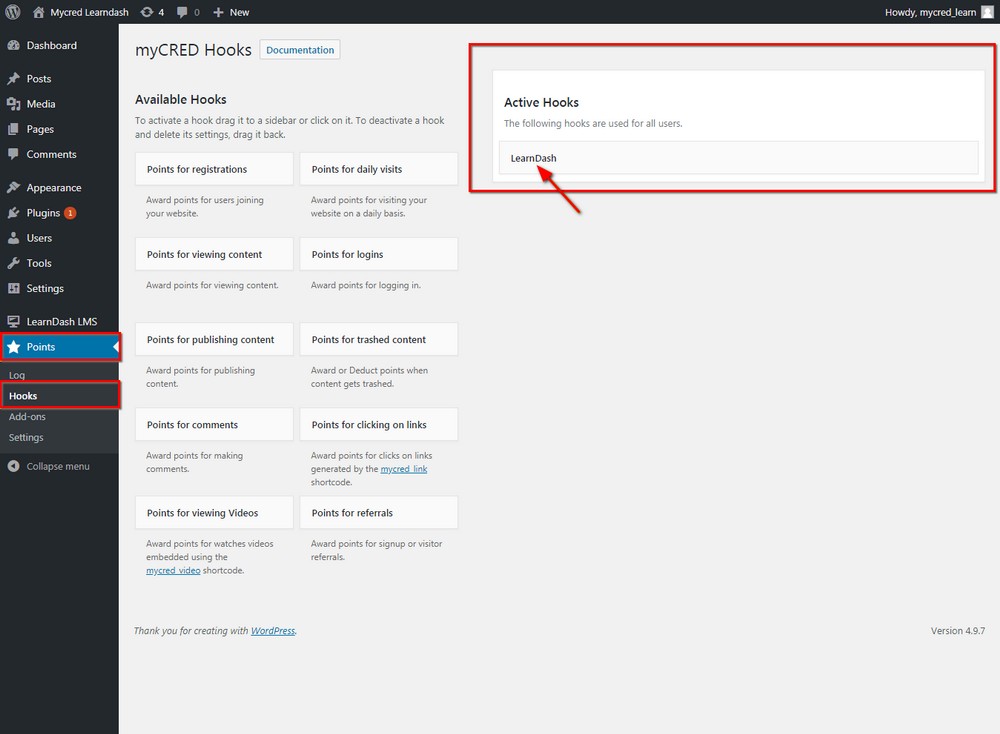
- Click myCred Hooks
- Select an available hook and drag it to the Active Hooks window on the right
- Select the number of points (tokens) to be awarded and the log template you’re using to track them
- Select Save once complete
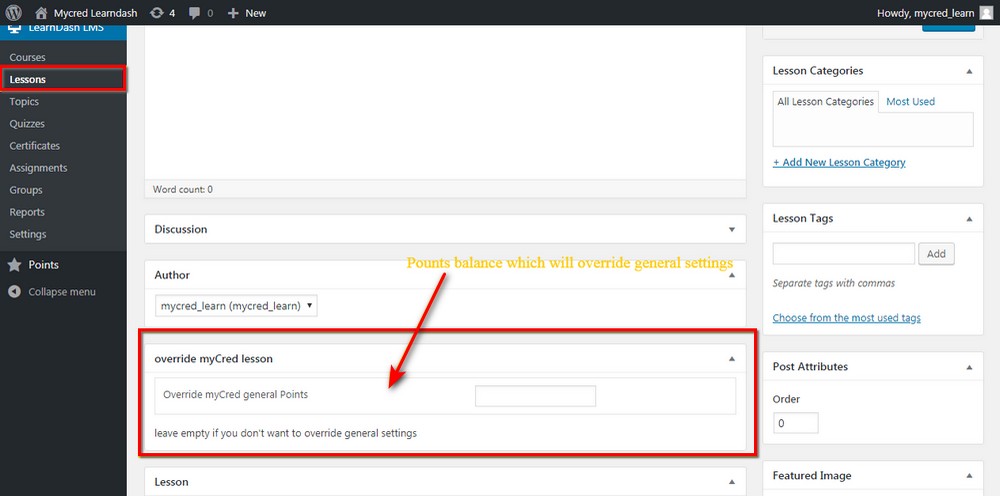
Set up points for specific courses, lessons, topics or quizzes
You can also set up unique points for individual courses or eLearning elements.
If you have set points across your LMS, you can skip this part. Otherwise, read on.
- Select LearnDash LMS from the WordPress dashboard
- Select Courses and the ‘override myCred course’ section under the content window
- Add lesson points that the student will earn when lessons are completed
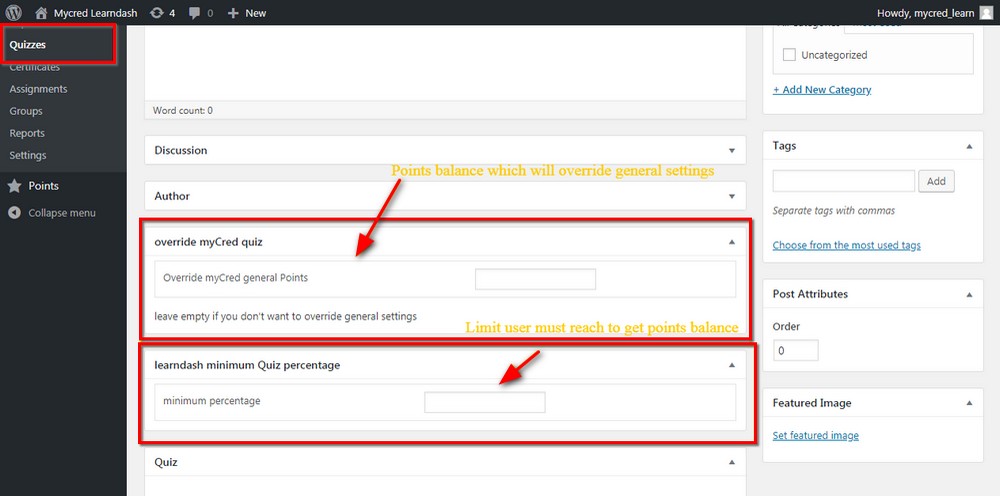
- Open LearnDash LMS, and click on the Quizzes menu
- Add the number of points which will override general settings
- Add a minimum percentage a student will need to earn those points
- Save the changes you made
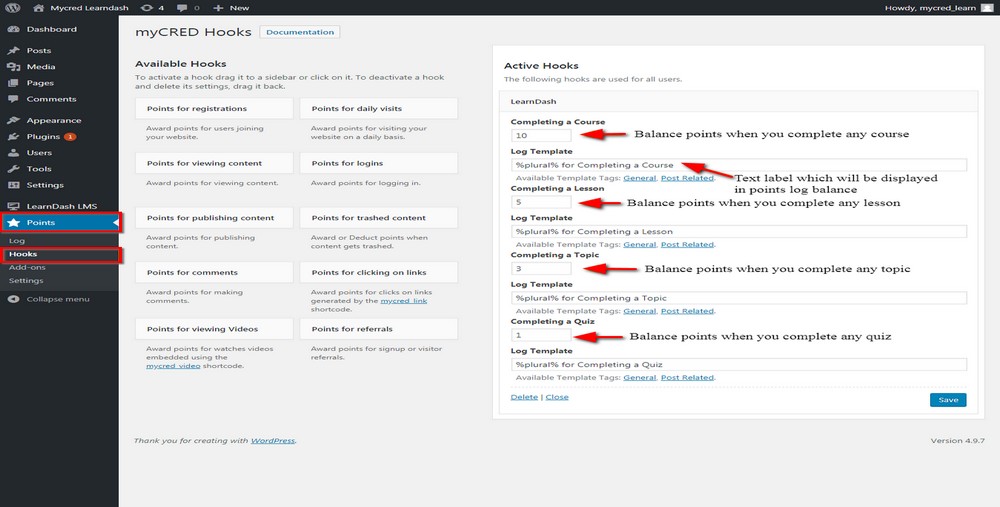
View user points logs
All points awarded to students will be stored in user logs. You can check these at any time to see how well students perform.
Select LearnDash LMS > Points > Log to see each entry.
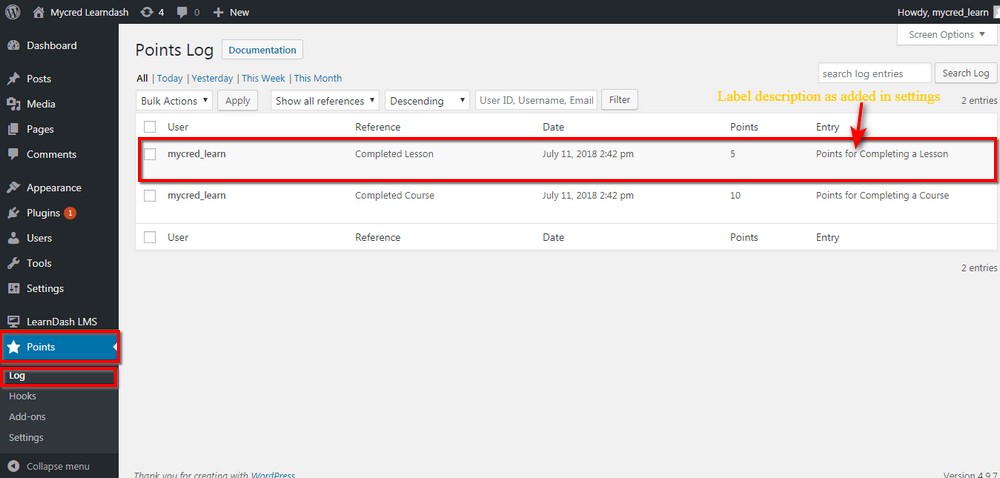
Advantages of the myCred LearnDash plugin
The following are some of the advantages of the myCred LearnDash plugin:
- Use a drag and drop builder to help gamify an LMS
- Help make learning fun and increase engagement
- Use our own psychology to help us learn and excel
- Simple system for setting up points and rewards
- Free version so you can try before you buy
Cons of myCred LearnDash
The following are some of the drawbacks of the myCred LearnDash plugin:
- Default payment options are limited
- Default membership options are limited
There are other gamification plugins for WordPress but we think myCred LearnDash is one of the better options.
It’s simple to use, mimics WordPress controls for creating points systems and allows you to check student progress whenever you like.
Plus, there’s a free option so you can try before you buy!
Conclusion
Gamification in eLearning is a powerful motivator that encompasses a variety of tools and techniques to help drive success.
It’s very powerful and is used almost everywhere in life in one for or another. You could leverage its power for your own learning website with ease.
If you want to build an effective learning management system, using gamification techniques is a simple, but very effective way to help improve engagement, encourage students to succeed and provide a little fun along the way.
And all you need is WordPress, LearnDash and the myCred plugin!
Have you used gamification on your LMS? Find it useful? Have students embraced it? Do they engage more? Tell us your story below!


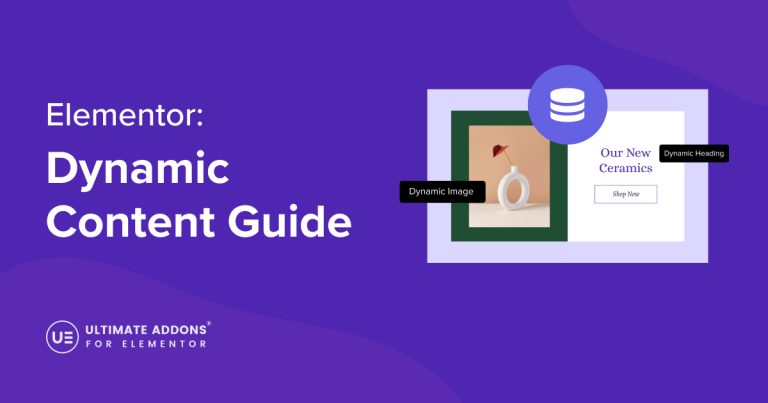

1 thought on “How to gamify an online course website”
Gamify plugin post Very Helpfull Post